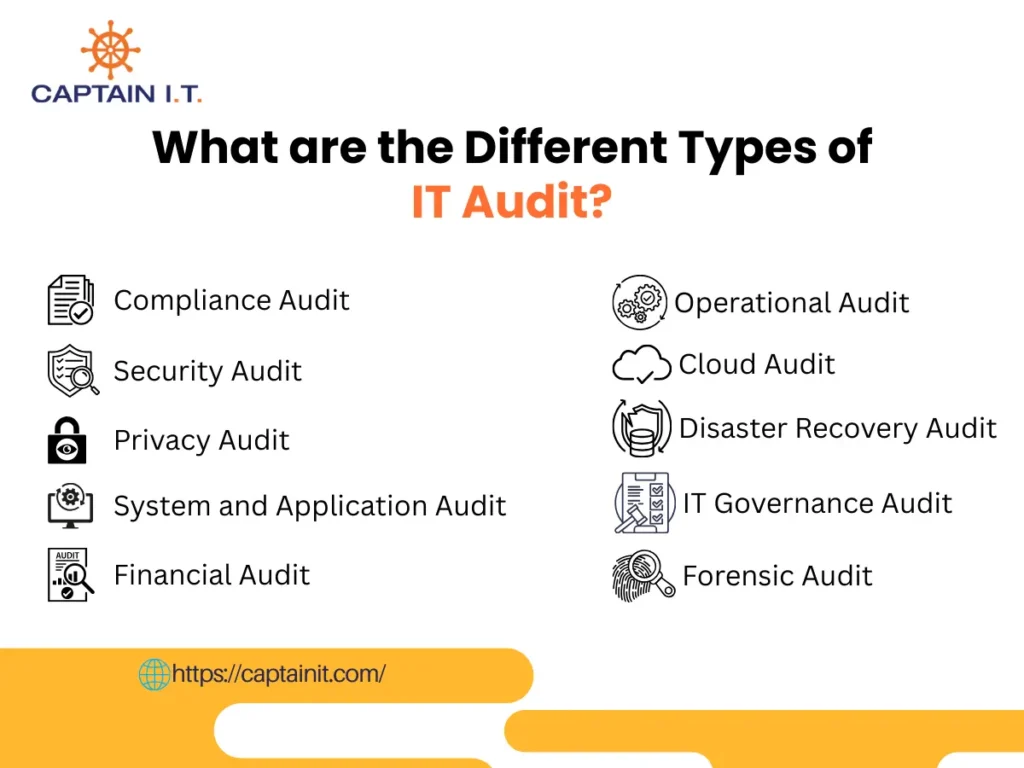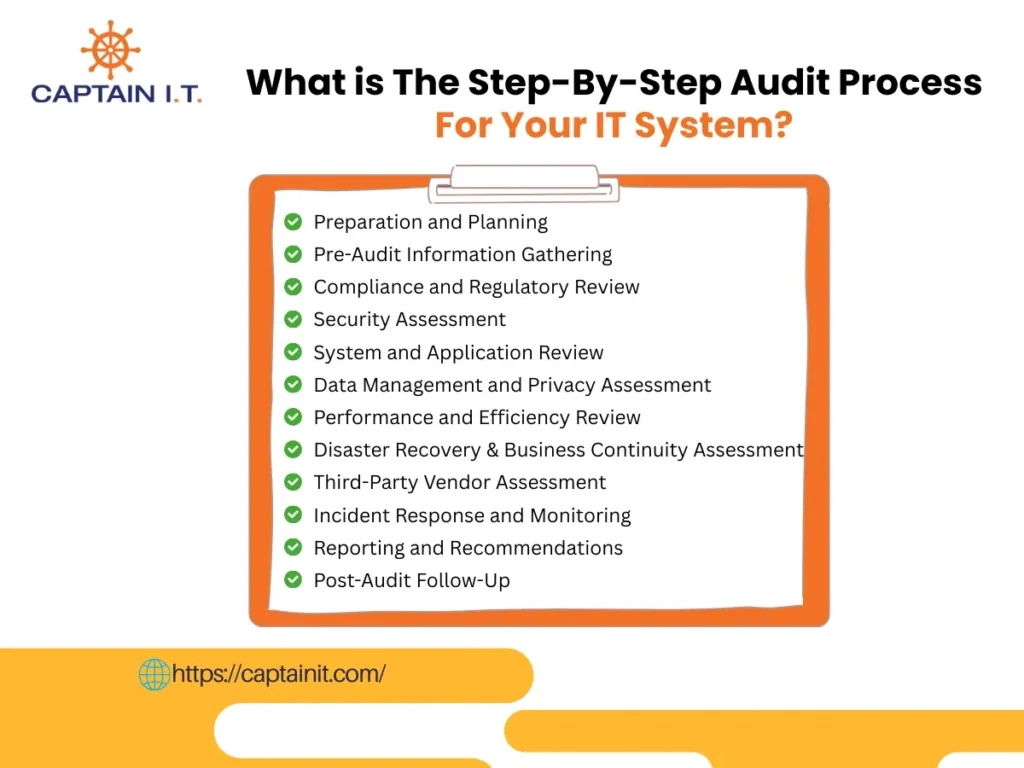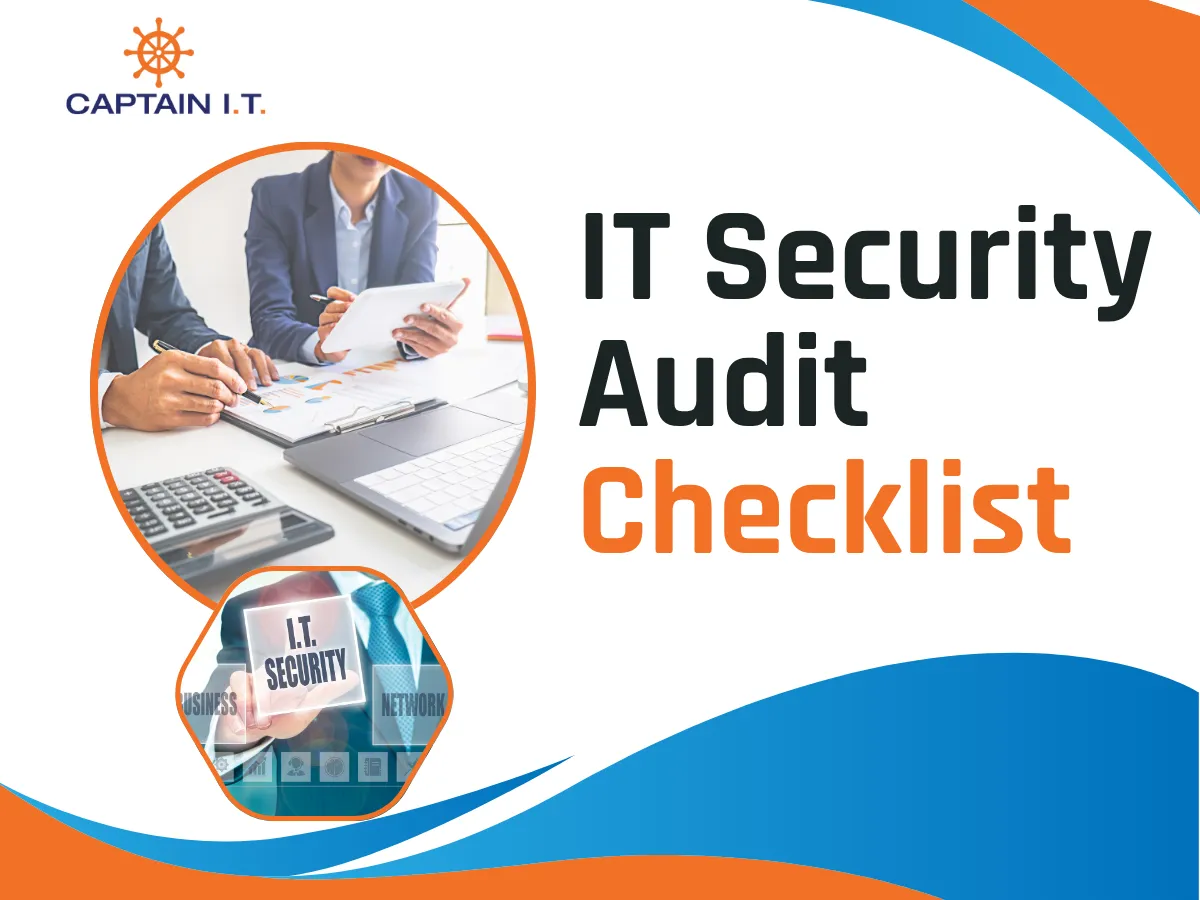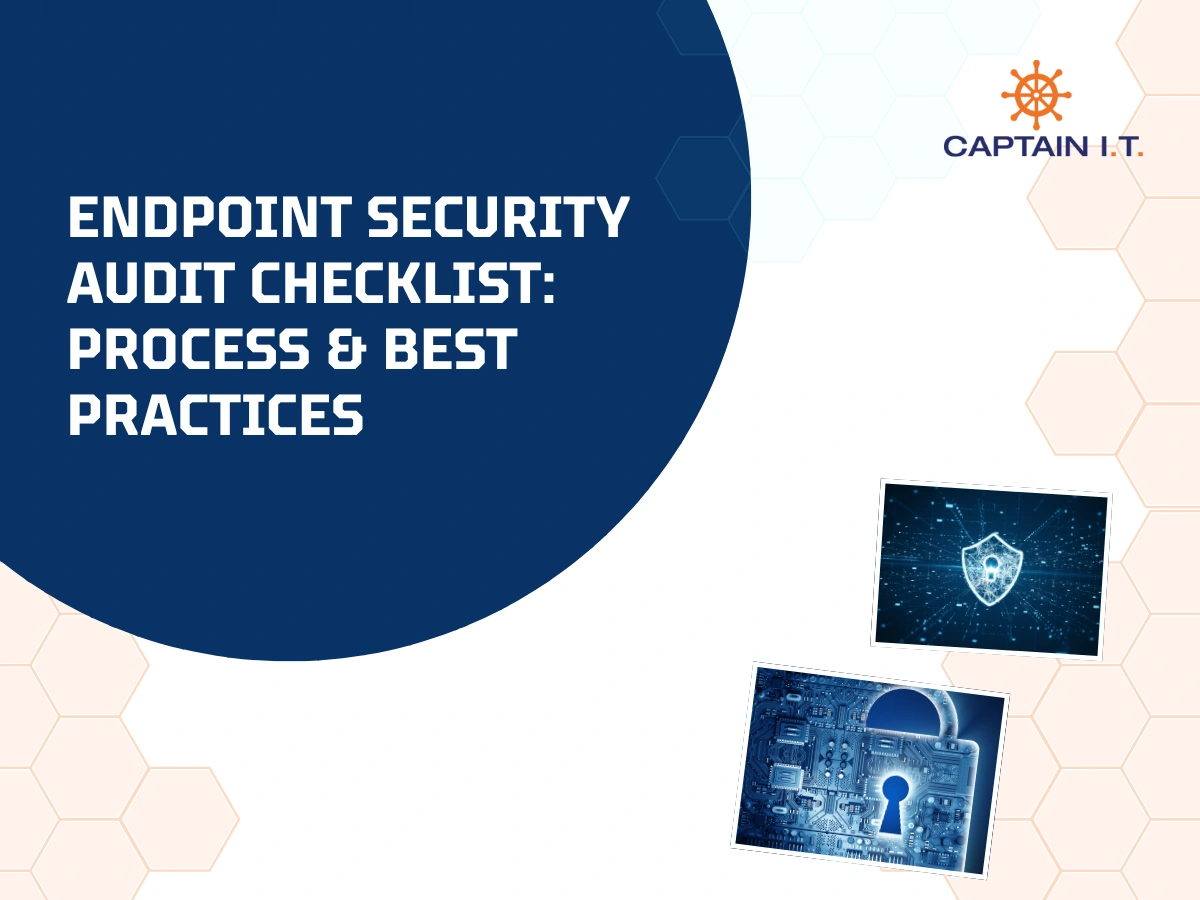What is an IT Audit Checklist?
An IT audit checklist is a structured framework used to evaluate an organization’s information systems for security, compliance, and operational effectiveness. It outlines checkpoints for access controls, data integrity, asset management, and incident response, ensuring alignment with standards like GDPR, HIPAA, and ISO 27001.
Effective IT audits rely on this checklist to assess network security, system performance, backup procedures, and user account governance. Each element of the audit is connected to a clear evaluation criterion, allowing auditors to validate controls, detect misconfigurations, and confirm that processes meet required standards. These checks help uncover risks in third-party integrations and ensure that business continuity measures are in place.
By using this framework, organizations improve governance, reduce downtime, and ensure infrastructure resilience. The checklist maps assets to compliance needs and assigns accountability for key systems, helping maintain a secure and audit-ready IT environment.
Why is the IT Audit Checklist Important?
An IT audit checklist is important for an efficient and consistent audit process. It ensures proper coverage of critical areas of IT infrastructure through a structured framework that helps organizations mitigate potential IT issues, maintain compliance, and strengthen security systems.
The 8 essential points highlighting the importance of the IT audit checklist are discussed below.
- Ensures Regulatory Compliance: Adheres to regulations like GDPR, HIPAA, and SOX, avoiding legal troubles and financial exposure.
- Validates Data Accuracy and Availability: Confirms the accuracy, accessibility, and proper backup of critical data and information.
- Improves IT Governance: Supports effective oversight and aligns decision-making with business objectives.
- Optimizes Resource Usage: Improves cost efficiency by identifying underutilized or overloaded systems.
- Enhances System Performance: Detects and addresses bottlenecks and configuration issues affecting network and application efficiency.
- Reduces Downtime: Helps prevent outages by ensuring resilient infrastructure and disaster recovery readiness.
- Mitigates Security Risks: Flags vulnerabilities and strengthens access control and encryption policies to protect data against data breaches and cyberattacks.
- Supports Strategic Planning: Provides data-driven and actionable insights that inform stakeholders for future IT investments and improvements.
What are the Different Types of IT Audits?
The different types of IT audits are compliance, security, financial, cloud, and forensic audits, each focusing on a specific aspect of the IT infrastructure. These audits help the systems operate securely, efficiently, and in alignment with organizational and legal requirements. A further description of each type of IT audit is provided below.

- Compliance Audit: Through a compliance audit, organizations demonstrate their adherence to legal, regulatory, and industry standards like GDPR, HIPAA, and SOX. It confirms the documentation and implementation of internal policies and procedures.
- Security Audit: Organizations undergo security compliance to verify the effectiveness of IT infrastructure against cyber threats. This audit reviews firewalls, encryption, threat detection systems, and access controls to identify vulnerabilities, gaps, and weaknesses that could be utilized by cyber attackers to breach the system and network..
- Privacy Audit: Using a privacy audit, companies assess the collection, storage, and processing of personal and sensitive information within the firm for top-notch security. It validates the proper handling of data and information under the privacy regulations and organizational policies..
- System and Application Audit: By focusing on the evaluation of the functionality, security, and performance of critical IT systems and software applications, system and application audits verify the configuration, performance, and security of critical data for data integrity while fulfilling business requirements.
- Financial Audit: With the goal of accurate reporting, compliance with accounting standards, and detection and prevention of data manipulation or fraud, a financial audit assesses IT systems and processes that manage or impact financial data or transactions. Its purpose is to maintain the integrity, reliability, and accuracy of financial data in the organization.
- Operational Audit: By targeting areas such as network performance, system uptime, resource utilization, and IT service management, an operational audit evaluates the efficiency and effectiveness of IT operations and processes within an organization. Conducting such assessments helps optimize workflows, reduce inefficiencies and redundancies, and improve service delivery.
- Cloud Audit: Companies perform cloud audits to assess the governance, security posture, and performance management of cloud-based systems and platforms. Through this audit, organizations review configuration, user access, and data residency in the cloud environment, which helps ensure compliance with industry standards. It also determines the optimal use of cloud resources through shared responsibility models.
- Disaster Recovery Audit: The purpose of a disaster recovery audit is to review the readiness and reliability of the organization’s disaster recovery and business continuity plans. It examines the backup systems, failover mechanisms, and recovery procedures to verify that critical systems and data can be restored swiftly after a disruption (disaster, cyberattack, or system failure).
- IT Governance Audit: IT governance audit assesses the management, control, and monitoring of IT resources to validate whether they align with business objectives and governance frameworks like COBIT and ITIL. It evaluates decision-making structures, accountability, and the management of IT-related risks and investments.
- Forensic Audit: Organizations only conduct a forensic audit when there are suspected incidents of fraud, data breaches, or cybercrime. Auditors carry out a detailed investigation to collect evidence and find the root cause of the incident. The findings of the audit support legal proceedings against the culprit and help companies reinforce organizational controls to prevent future recurrences.
What is Included in an IT Audit Checklist?
An IT checklist includes every critical aspect of IT infrastructure, ranging from network, infrastructure, and data security to disaster recovery and IT governance. Each category focuses on critical components that collectively support a resilient, compliant, and optimized IT environment.
Network & Infrastructure
Auditors begin by reviewing the reliability and security of the organization’s core networking components.
- Evaluate firewalls, routers, and switches for configuration and security vulnerabilities.
- Review network segmentation to prevent unauthorized lateral movement.
- Inspect Wi-Fi security settings, including encryption and access control.
- Verify traffic logging and anomaly detection mechanisms.
- Ensure proper patch management for all network devices.
- Assess physical security, including cooling and power backups to prevent downtime, overheating, and unauthorized access to critical IT assets.
Endpoint & Device Security
This category focuses on securing end-user devices and preventing endpoint-based threats.
- Assess security controls on desktops, laptops, mobile devices, and IoT devices.
- Check the effectiveness of antivirus, EDR, and XDR tools.
- Verify restrictions on USB ports and external media.
- Confirm the use of device-level encryption to prevent data theft.
- Review privileged access management policies for endpoint users.V
- Validate automated patching for endpoint operating systems.
Data Security & Backup
This section addresses how data is classified, encrypted, stored, and recoverable in case of loss.
- Validate data classification protocols (e.g., public, confidential, sensitive).
- Check encryption standards for data at rest and in transit.
- Review backup schedules, both onsite and offsite/cloud-based.
- Test restoration procedures to confirm data integrity.
- Evaluate access control policies for databases and repositories.
Cloud & SaaS Security
Auditors assess how cloud-hosted systems are secured and monitored under shared responsibility models.
- Review cloud provider security documentation and shared responsibility models.
- Assess IAM (Identity and Access Management) configurations.
- Confirm the enforcement of multi-factor authentication (MFA).
- Validate data residency and compliance with regulations such as GDPR and CCPA.
- Conduct periodic cloud security posture assessments.
Physical Security
Infrastructure protection is incomplete without evaluating how physical access to IT assets is managed.
- Inspect access controls for data centers and server rooms (e.g., badge systems, biometrics).
- Review the deployment of CCTV surveillance and the presence of security personnel.
- Evaluate visitor management policies for restricted IT areas.
- Check for fire suppression, climate control, and environmental monitoring systems.
Security Policies & Awareness
This area ensures that employees understand and follow cybersecurity protocols.
- Review all IT security policies for relevance, completeness, and updates.
- Verify regular cybersecurity training for phishing, password hygiene, and social engineering.
- Check the implementation of incident reporting procedures across departments.
- Assess the use of role-based access control (RBAC) across systems.
- Evaluate results of security awareness testing (e.g., simulated phishing).
Business Continuity and Disaster Recovery Plans
Effective recovery planning is vital to minimize downtime during emergencies or system failures.
- Review and validate disaster recovery documentation.
- Confirm Recovery Time Objectives (RTO) and Recovery Point Objectives (RPO).
- Verify testing frequency and outcomes of disaster recovery drills.
- Evaluate system redundancies and alternate data center arrangements.
- Ensure alignment with the overall business continuity strategy.
Incident Response and Monitoring
The ability to quickly detect and respond to IT incidents is essential for limiting impact and recovery time.
- Review incident response plans, roles, and escalation procedures.
- Inspect the deployment of SIEM, IDS, and log analysis tools.
- Verify that system and user activity logs are generated, retained, and reviewed regularly.
- Assess processes for real-time threat monitoring and alert management.
- Evaluate handling of past incidents and apply lessons learned.
IT Governance
Auditors analyze how IT decision-making, risk oversight, and resource alignment are managed.
- Assess the alignment of IT goals with the overall business strategy.
- Review the use of governance frameworks like COBIT, ITIL, or ISO 27001.
- Examine decision-making structures and policy enforcement mechanisms
- Verify how IT risks are identified, documented, and mitigated.
- Evaluate oversight roles and accountability tracking.
Documentation and Reporting
Proper documentation supports audit traceability, accountability, and continuous improvement.
- Ensure maintenance of audit trails for system changes and access events.
- Review the completeness of past audit reports and remediation tracking.
- Confirm that findings are prioritized based on risk level.
- Check that the evidence (e.g., logs, screenshots, test results) supports conclusions.
- Evaluate how corrective actions are communicated and implemented.
What is The Step-By-Step Audit Process For Your IT System?
The step-by-step audit process for an IT system should follow a well-organized sequence that begins with evaluation and planning, continues through various assessments, and ends with reporting and follow-up. Each phase is critical for validating the organization’s security posture, regulatory compliance, system efficiency, and risk management through actionable improvement.

- Preparation and Planning: The first stage of an IT audit includes establishing clear goals, defining scope, and gathering the right resources. The primary focus, whether security, compliance, or performance, must be defined, and the IT systems, applications, and processes requiring assessment must be clarified. Organizations should set the right tools and personnel for the evaluation. It is crucial to set a structure and a realistic timeline so all phases are conducted without delays.
- Pre-Audit Information Gathering: Collecting contextual and technical information related to security policies, network diagrams, system configuration, and access logs to understand the IT landscape comes next. Auditors should meet IT leaders and stakeholders to identify key areas of concern and perform an initial risk assessment to prioritize systems and processes that require special attention during the IT audit.
- Compliance and Regulatory Review: The next step is to review the regulatory alignment with GDPR, HIPAA, PCI-DSS, and other applicable frameworks to avoid legal troubles and financial penalties. Auditors use a structured compliance checklist to confirm compliance with industry standards and alignment with internal policies. They also review service-level agreements (SLAs), contracts, and audit trails to ensure that legal and contractual obligations are met.
- Security Assessment: IT auditors evaluate the effectiveness of firewalls, intrusion detection systems (IDS), and the overall network architecture to confirm proper user access controls, least privilege enforcement, and authentication protocols. They conduct vulnerability scans and penetration testing to identify weaknesses and gaps before they are exploited and used against the organization.
- System and Application Review: The fifth step is to asses operating systems, databases, and network devices for recent patches and updates to ensure systems and applications are secure and correctly configured. Auditors examine commercial and custom-built applications for security risks and performance issues. They also verify whether the patch management process is consistent to mitigate potential threats from unpatched vulnerabilities.
- Data Management and Privacy Assessment: In this step, auditors examine the classification, storage, and security of data to ensure the proper implementation of strong data governance that protects sensitive information. They also validate that privacy controls comply with GDPR, CCPA, and SOX. They test backup procedures and data recovery mechanisms to ensure data availability in case of failure or breach.
- Performance and Efficiency Review: Auditors then analyze the effectiveness of IT systems, networks, and applications and their functionality to determine delays and inefficiencies. They assess the usage of CPU, RAM, disk space, and other IT resources to detect overuse or underuse. Their role is to verify whether the current infrastructure can scale effectively with business growth and demand. This also helps in avoiding bottlenecks and downtime.
- Disaster Recovery and Business Continuity Assessment: Through this step, auditors test the organization’s preparedness and disaster recovery plan for system failure and operational disruption by evaluating Recovery Time Objectives (RTOs) and Recovery Point Objectives (RPOs). They also detect redundancy in critical systems to ensure continuity in business operations during unexpected events.
- Third-Party Vendor Assessment: Auditors also review third-party vendors, their processes, and services for risk compliance and alignment with internal controls. They review vendor contracts and SLAs to confirm compliance with internal standards and regulations. It also includes assessing risks associated with cloud services, MSPs, and outsourced support teams, and the effectiveness of their security control protocols.
- Incident Response and Monitoring: With the acknowledgment of an effective incident response plan, ongoing detection, and threat mitigation for cyber resilience, auditors verify the effectiveness of monitoring tools like SIEM and IDS for detecting, reporting, and resolving incidents. They also review past incidents to determine whether lessons were documented and improvements were implemented.
- Reporting and Recommendations: After the technical review, auditors create a detailed report including all identified risks, vulnerabilities, and inefficiencies with supporting evidence. They also provide practical, actionable recommendations specific to each identified issue. Findings are then shared with IT leadership and relevant stakeholders for approval and guidance on the next steps.
- Post-Audit Follow-Up: Once the report is submitted, organizations should implement corrective actions by collaborating with IT and compliance teams to bring actual improvement and maintain momentum. Auditors track remediation progress and validate the resolution of identified risks. They also schedule ongoing monitoring and follow-up audits to maintain improvements, manage evolving threats, and reinforce continuous compliance.
What are the IT Audit Checklist Best Practices?
IT audit checklist best practices include defining clear objectives, following a structured framework, ensuring compliance, monitoring third-party risks, and implementing continuous auditing. These essential actions and standards ensure that audits are effective and consistent with business requirements. These industry-leading practices help organizations unravel existing risks, verify controls, and improve continuously to safeguard IT systems and processes.
- Define Clear Objectives: Organizations should always have a clear thought process about what they want out of an IT audit. Well-defined objectives help to steer the overall audit in the right direction. It helps to keep the audit aligned with the intended purpose, whether it is improving security, verifying compliance, or evaluating performance.
- Follow a Structured Framework: A proper and effective IT audit should be based on a standardized framework for credibility and consistency. Following ISO 27001, COBIT, NIST, or PCI DSS frameworks provides predefined criteria and processes that help to keep the audit systematic. It also helps to comply with industry-recognized best practices.
- Assess Risk Proactively: Your priority should be to identify vulnerabilities and gaps before they escalate or are exploited. Organizations should categorize the risk and dedicate intensive resources to high-risk areas that require immediate attention. These are the critical areas that significantly impact business operations and halt productivity.
- Ensure Regulatory Compliance: Businesses should proactively identify risks and ensure that all the systems and processes align with all applicable legal standards, including SOX, GDPR, and HIPAA. Maintaining compliance with these regulations helps avoid penalties and legal troubles and upholds the organization’s reputation in the market.
- Evaluate Security Controls: Organizations should bring in expert auditors to evaluate security measures like access controls, firewalls, and encryption mechanisms so there are no gaps or vulnerabilities that can compromise systems or networks, leading to data breaches and theft. These control measures help businesses safeguard their IT infrastructure against threats while complying with security policies.
- Verify Data Protection Measures: Organizations require a multi-layered protection approach to safeguard their data and sensitive information. They should automate their backup systems and test them regularly to verify their functionality. Using data encryption during transmission and storage helps protect data in transit and at rest. Also, having clear data retention policies allows them to define how long data is kept and how it is securely disposed of.
- Analyze Network and System Performance: You should evaluate IT performance to identify existing bottlenecks and inefficiencies within your organization. The things you should consider examining include network traffic patterns, system resource utilization, and uptime logs. Assessing these aspects ensures business operations are performed optimally and IT functionality is not disrupted.
- Monitor Third-Party Risks: When IT tasks are outsourced to external vendors or MSPs, there looms the question of data security and control of IT functions. Therefore, these third-party vendors should be verified whether they meet the same security and compliance standards as internal systems. Auditors should examine their security practices, certifications, and access permissions to ensure there is no risk of data breaches and unauthorized access.
- Documentation and Reporting: There should be a practice of documenting the audit results in a detailed and transparent manner. These reports should prioritize findings with supporting evidence and actionable recommendations that allow stakeholders to address issues efficiently and track the overall resolution progress.
- Implement Continuous Auditing: Auditors should vouch for continuous auditing that helps develop a striking culture that provides real-time visibility into vulnerability and performance gaps. They should introduce the collaboration of automated monitoring tools with regularly scheduled audits to get ahead of evolving risks and maintain long-term compliance in the organization.
Ensure Compliance and Optimize IT Performance With a Comprehensive IT Audit
A comprehensive IT audit helps organizations maintain regulatory compliance, strengthen cybersecurity, and improve overall system performance. With increasing pressure to meet standards such as GDPR, HIPAA, and ISO 27001, businesses must routinely evaluate their IT infrastructure to detect vulnerabilities, validate data protection measures, and ensure operational efficiency.
At Captain IT, we specialize in delivering structured, end-to-end IT audits that help organizations streamline operations, optimize resource allocation, and support long-term business continuity. Our expert-led audit services provide actionable insights that align IT systems with both compliance requirements and business goals, ensuring your technology works securely and efficiently at every level.



